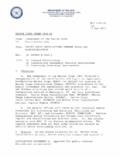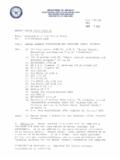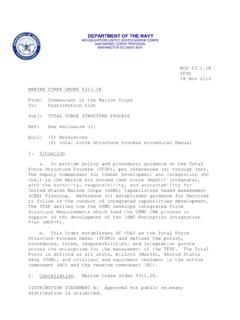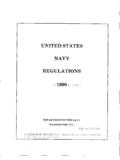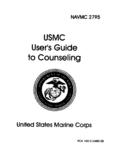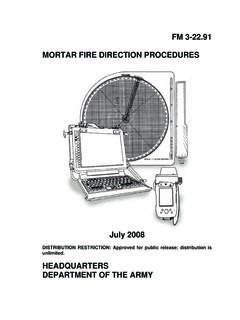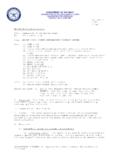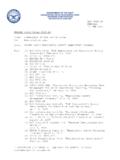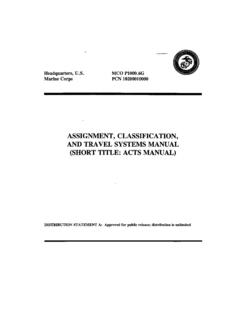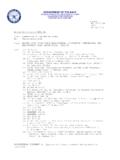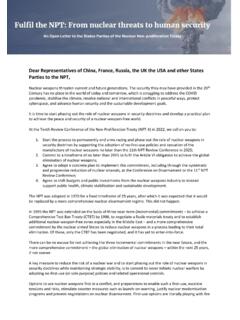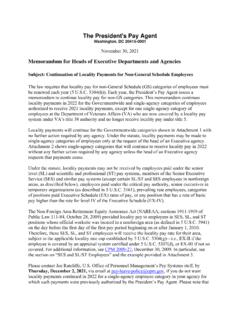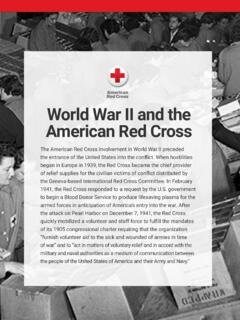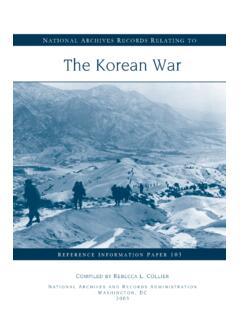Transcription of U.S. MARINES KOREAN WAR - United States Marine Corps
1 MARINESINTHEKOREAN WARE dited byCharles R. SmithHistory DivisionUnited States Marine CorpsWashington, 106 0000 0100 ForewordTheanthologyofarticlesthatfollow swascompiledbytheHistoryandMuseumsDivisi onduringthe50thAnniversarycommemorationo ftheKoreanConflict, "forgottenwar."Forgottenornot, , ,Korearepresentedthebeginningofa seriesof"limitedwars" , totalwaragainstanenemywhoseobjectiveswer eclearlyiden-tifiable,theKoreanconflictp rovedfraughtwithpoliticaltwistsandturnst hatmadethemilitary' "stalemate"phaseofthewar, ,thisperiodoftheconflictsawtheMarineCorp sincura , "comeasyouareaffairs."Duringthesummerand earlyfallof1950,theMarineCorpslearneda valuablelessonwhenithadtoscrambletoassem bleitslandingforcefortheInchonoperation, ,forthefirsttime, , "flakjackets" (Provisional)in1941, , , , , ,underthedirectionofthenHistoryandMuseum sDivisionDirector, , ,letuspledgetoneverforgetthoseMarineswho servedandsacrificedinthissupposedly"forg ottenwar.
2 "Itwasentirelyduetotheirmilitaryachievem entsatInchon,atChosinReservoir,orinfoxho lesandbunkersalongthe38thParallelthatweh avea KOREAN War was the first major armed clash between Free World and Communist forces, in whatwas to be called the Cold War. It was waged on land, on sea, and in the air over, and near the Koreanpeninsula, for more than three years. Among the forces committed on this far-off battlefront, itwas once again the Marine Corps component that stood out in its sacrifice, military skills, and devo-tion to duty. When rushed into the battle during the first desperate weeks and months of the war, thequickly-organized and rapidly deployed 1st Provisional Marine Brigade and Marine Aircraft Group 33helped to restore stability to the shattered Eighth Army front line around Pusan. It would he thefirst time that Marine air and ground elements, task organized under a single commander, had engagedin the daringly conceived and executed United Nations counterstroke at Inchon, Marinesaccomplished this incredibly complex amphibious operation and the subsequent recapture of theSouth KOREAN capital, Seoul, with their customary spirit and precision, delivering a tactical blow thatbroke the backbone of the North KOREAN People's Army 1950 offensive.
3 Never was Marine heroismand perseverance more conspicuous than during the bitter days of the Chosin Reservoir campaign, fol-lowing the intervention of large-scale Chinese Communist Forces. Integrated ground and air actionenabled more than 14,000 Marine , Army, and Royal Marine troops to break out of the entrapment andmove south. The 1st Marine Division, considered by many to have been lost, properly evacuated itsdead and wounded, brought out all operable equipment, and completed the withdrawal with tacticalintegrity, all the while dealing a savage blow to the the war of fire and movement turned into one of positional warfare that marked the final oper-ations in Korea, the 1st Marine Division and 1st Marine Aircraft Wing again executed their respectivemissions with professional skill and dispatch, regardless of tactical problems and the dreary monoto-fly that characterized the fighting around the Inje River and Hwachon Reservoir in the Punchbowl area,and the critical 35-mile front in West Korea near more than half-century that now separates us from the KOREAN conflict has dimmed our col-lective memory.
4 Many KOREAN War veterans considered themselves forgotten, their place in historysandwiched between World War II and the Vietnam War. This compilation grew out a joint endeavorby the Marine Corps History and Museums Division and Marine Corps Heritage Foundation to reme-dy that perceived oversight by highlighting the contributions and honoring the service of those Marinesfor today's MARINES and the American people. The well-researched and highly-illustrated monographs,and now chapters, were written by Colonel Joseph H. Alexander, Captain John C. Chapin, BrigadierGeneral Edwin H. Simmons, Colonel Allan R. Millet, Bernard C. Nalty, Major General John P. Condon,Commander Peter B. Mersky, USNR (Ret), and Lieutenant Colonel Ronald J. Brown, all distinguishedhistorians, experts, or respected authors and editor gratefully recognize and thank all who assisted in the preparation of theoriginal monographs and of this volume by aiding in research and supplying photographs.
5 Amongthem are the professional staffs of the former Marine Corps History and Museums Division, now theHistory Division, Quantico, Virginia; the Marine Corps Heritage Foundation, Quantico, Virginia; theNaval Historical Center, Washington, ; the Archives and Special Collections Branch, Library of theMarine Corps , Quantico, Virginia; and the Modern Military Records and Still Pictures Branches of theNational Archives and Records Administration, College Park, Maryland. And to the more than 150,000 MARINES who served in Korea, and the 4,267 killed and 23,748 wounded in action, we say thank R. SmithEditor4 ContentsForeword3 Preface4 Chapter1 ,USMCR(Ret)7 Chapter2 ,USMC(Ret)73 Chapter3 ,USMC(Ret)143 Chapter4 ,USMC(Ret)209 Chapter5 ,USMCR(Ret)343 Chapter6 ,USMCR(Ret)413 Chapter7 ,USMC(Ret) ,USNR(Ret)607 Chapter10 ,USMCR(Ret)6655 FIRE in the Pusan Perimeterby Captain John C. Chapin, USMCR (Ret)heMarineshavelanded.
6 " How familiarthephrase,howextraordinary the cir-cumstanceson2 August 1950. Instead of a beachsaturated with enemy fire,thescene was a dock in the port ofPusan in the far southeast cornerof Korea. The landing force wasthe 1st Provisional Marine Brigade;the situationit would soon facewas one of desperate men arriving on board thetransport ships that day knew theywere going into battle, and theirbrigadecommander,BrigadierGeneral Edward ,hadmade his combat standards veryclear in a meeting with his officersbefore the ships had sailed fromSan Diego: "It has been necessaryfor troops now fighting in Korea topull back at times, but I am statingnow that no unit of this brigadewill retreat except on orders froman authority higher than the 1stMarine Brigade. You will neverreceive an order to retreat fromme. All I ask is that you fight asMarines have always fought."At sea, no one knew where thebrigade would be committed toaction, and the men knew nothingAT LEFT: Moving to attack.
7 A cor-poral leads his automatic-rifleman through a rice paddy,oblivious to the dead enemy sol-dier underfoot. Photo by DavidDouglas Duncanabouttheforthcoming enemyexceptitwas called the NorthKorean People's Army (NKPA). Onboard their ships they had seen thesituation maps which daily showedthesteadilyretreatinglineofdefense , as the enemy drove irre-sistablyfarther and fartherintoSouth Korea. The regular physicalfitnessdrills and weapons targetpractice took on an urgent newsense of purpose for the Francis I. "Ike" Fenton,Jr.,thenexecutiveofficerofCompany B, later recalled:While on board ship ourtraining area was an impossibility to getthe whole company togetherat one location. Consequent-ly, we used passageways,boat decks, holds any spacewe could find to lecture tothe men and give them the lit-tle information that we had asto what was happening lectured on the charac-teristics of the T-34 tank andtold the men about the kindof landmines we mightexpect.
8 A lotof time wasspent on blackboard tacticsfor the fire team, platoon, andcompany. We had launcher, but no onepresent had ever fired variety of old World War IIships had brought Force had 10 ships. Twotransports and a light carrier, theBadoeng Strait (CVE-1 16),trans-7ported the air arm, Marine AircraftGroup 33 (MAG-33). Two LSDs(landing ships, dock), two AKAs(cargoships, attack),and threeAPAs (transports, attack) providedfor the ground units. Pulling upalongside the dock at Pusan, themen of the brigade were split intothree main units: the 2d Battalion,5th MARINES , on the George Clymer(APA-27), known to its passengersas the "Greasy George"; the 3dBattalion on the Pickaway (APA-222), with the regimental comman-der of the 5th MARINES , LieutenantColonel Raymond , onboard; and the 1st Battalion on theHenrico (APA-45), which camelimping into port last after a seriesof mechanical problems (eventhoughitwas known asthe"Happy Hank").
9 Standing on the pier to meet themen was a disparate group of peo-ple: General Craig; MARINES whohad guarded the Embassy staffin its perilous journey all the wayfrom the South KOREAN capital ofSeoul to refuge in Pusan; Army soldiers; a local bandgiving an earnest but painfullyamateurishrenditionofTheMarine Cops Hymn; crowds ofcurious South KOREAN on-lookers;and undoubtedly someNorthKorean was shocked to see theMarines watching the docking, asthey casually leaned over the railsof their ships. He had previouslysent an order through Army chan-nels for the brigade to be preparedto march off the ships, combatready, with weapons loaded. Hisimmediate, sharp inquiryto anofficer on board revealed that hisorders had never been received atsea. Accordingly, Craig immediate-ly convened an officers'confer-ence on G-3, ,announcedthatthebrigade would move out at 0600the following morning. This meantthe men would spend the wholenight unloading the ships and issu-ing fullsupplies of ammunitionand rations, so that the brigadecould move out on clear that he did not yetknow where the brigade would besent by Lieutenant General WaltonH.
10 Walker, the commanding officerof the Eighth Army in Korea,8 Craigconcluded:"ThePusanperimeter is like a weakened dikeand we will be used to plug holesin it as they open. We're a brigade, be costlyfightingagainstanumericallysuperio r havenever yet lost a battle; this brigadewill not be the first to establishsuch a precedent."After a night of bedlam on thewaterfront, 9,400 tons of supplieshad beenunloaded,butthebrigade was to travel light, so mostof these supplies and all personalbaggage had to be left it was that the brigade wasready to move out on the morningof 3 was still uncertainty as toexactly where the men wouldenter combat. Walker's headquar-ters had telephoned Craig at mid-night and told him to move thebrigade to a town called Chang-won, where Walker would tem-porarily hold the MARINES in EighthArmy reserve. This would positionthe brigade strategically if Walkerdecided thathismost pressingdanger was an enemy break-through threat by the NKPA 6thInfantry Division and the 83dMotorcycle Regiment.
